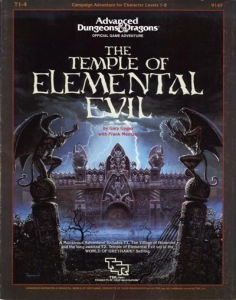There is one thing about writing as a stream of consciousness, the way I started with the first two parts of this series. You keep getting ideas and more thoughts cram into your head. One thing I like about blogging vs vlogging is that the mass of craziness that fill my mind has to be organized. I can't just blurt out twelve things at once. So while I originally planned a two-parter... I had to expand this to a third part...
Because of the many side ideas and thoughts I came up with were related but not really formed, I put them at the bottom of the text file for later as I kept on thinking about shorter stuff. But then, after I completed the two posts (it was one I decided to later split in two), I saw the many ramblings and partial thoughts: "Masks x 3", "I3-5", "longer=more dev/harder" and a few that just don't make sense. Enough rambling, here is the post, after a little clean up...
Mega-Modules or Adventure Path
Having put down my thoughts on one-shot modules (Part 1) and on tournament adventures (Part 2), I had more to say about mega-modules or the adventure path format.
Those old modules, with names we all know: the Tomb of Horrors, the Expedition to the Barrier Peaks, and Castle Greyhawk became household names the same way Paizo's Runelords are now part of the gaming universe. The reason is deceptively simple:
Because we played them.
Old guys like myself all have tales of someone doing something stupid in one of these adventure and creating comedy gold. I mean, it is funny to see your friend getting disintegrated because he touched the big red button.
I do not play many of them, because of the logistics and time to complete. I was able to play through one of Paizo's adventure paths (Reign of Winter, shout-out to Chad and Evan who GM'd it for me), but never got a chance to play in a 5e mega module all the way through (I played parts of them as part of the Adventure League).
 Back in the days, I played Desert of Desolation (I3-5), Egg of the Phoenix (I12), and significant parts of both Queen of Spiders, and Temple of Elemental Evil (T1-4) back in the day, including the PC game of ToEE.
Back in the days, I played Desert of Desolation (I3-5), Egg of the Phoenix (I12), and significant parts of both Queen of Spiders, and Temple of Elemental Evil (T1-4) back in the day, including the PC game of ToEE.
The best thing about them is the amount of story and adventure there is to do, all in the same theme. It's not just to get in, beat up the goblin king and get out. From fairly innocuous beginnings, your character becomes involved in a greater plot, in some massive affair. This means that you get to take part in something massive.
That is also their biggest downfall. Because there is so much to do, and often the plot becomes personal to the PCs, after one or two characters die, or after a few player cycle in and out, the party's motives are difficult to maintain. I will tell you of the Mask of Nyarlathotep in another post for a good example of this. Plus remembering all the details of what you did two years ago because of the long time between games. Back on track, After the 4th book of an adventure path - or the third full dungeon level - the initial motivation for adventure is not as strong, and the question of "why are we doing this again?" props up. I find it difficult to keep up the interest from that point.
Another strength/weakness is that such large-scale adventures have a theme: WotC's Curse of Stradh and Paizo's Carrion Crown is Gothic Horror, Reign of Winter deals with the mythology of Baba Yaga, Tyranny of Dragons deals with Tiamat and dragon cults, Wayof the Wicked deals with evil characters, etc. There is a lot to do. The flaw? Some people have no interest in the theme. Say you don't like long wilderness exploration (I'm not really that much into it), then a mega-module is just not for me. The chance of me running it is zero and the chance of me playing and giving the game a high level of interest as something I love is not the same.
Dang... the strength of these modules is also its weakness.
Looking at their physical size, WotC's Curse of Stradh, Dragon Heist, Princes of the Apocalypse all are 256 pages, while Paizo Adventure Paths and 6 books of 64pages (each book has 32 of adventure and 32 of setting), they are now reducing this to 3 books, a decision I am very happy about because it will keep the plots more concise and address the issues I mentioned above. Three books means your opening motivation easily holds through. Also, the best ideas are the ones that win through.
These adventures are written by different people, each with their own style. As a small publisher, this is one of the toughest type of product to create. But as a GM, and as a player, a bigger scope adventures are more rewarding to take part in because you get to delve more into the party dynamic, get to play with more things.

No comments:
Post a Comment